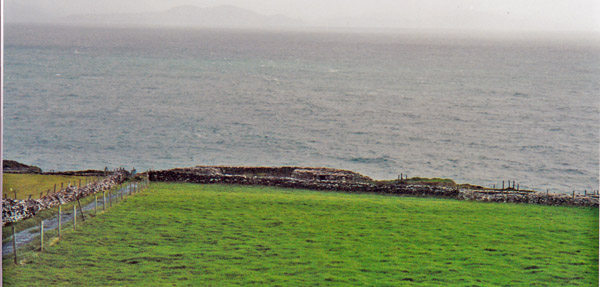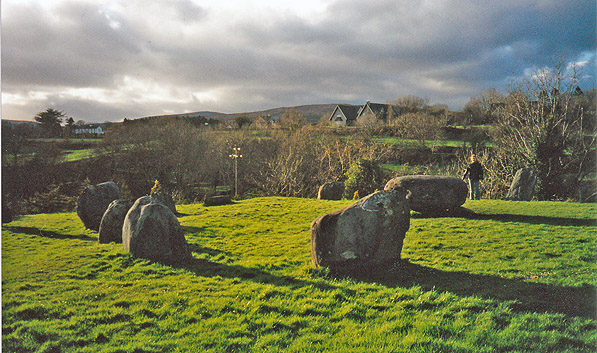
Dunbeg Stone Promontory fort in County Dingle, Ireland. Many of these forts still remains in Ireland. They are built with dry walls of massive stones, and most have concentric circles (Dunbeg has four). Although built from the late Bronze Age and used through early medieval times, most are referred to as Iron Age forts. Photo Credit Mark Kane

Prehistoric man created sacred places and shrines and designated landscape features as spiritually significant. Many but not all of these places were related to ceremonial burial. Sacred places were sometimes created or marked by the erection of megaliths, which are huge constructions of wood or stone. Megaliths were virtually universal, found on every continent occupied by prehistoric man. Stone circles were a subset of megalithic construction.
Other types of religious monuments included causeways, cursuses, barrows, henges, and cromlechs. These were basically single or combinations of ditches, banks, track ways, palisades, pillars, and tree trunks and wooden posts. These occasionally were located in proximity to stone circles.
More commonly related to stone circles were orthostats (single upright stones), which included pillars that might be carved with anthropomorphic or geometrical drawings. Menhirs were rows of stones, sometimes forming fans shapes or bordering avenues, and might have been associated with stone circles.
Standing stones, arranged in circles, arcs, or ellipses, were first erected in the third and second millennia bce. (Jane McIntosh, Handbook to Life in Prehistoric Europe, 2006. p. 264) Stone circles were almost exclusive to current day Great Britain, Ireland, and Brittany in France. (McIntosh, pp. 264-5) In the Guide to Stone Circles of Britain, Ireland, and Brittany, Aubrey Burl listed 390 modern-day sites with stone circle remnants. (Aubrey Burl, A Guide to Stone Circles in Britain, Ireland, and Brittany, 1995. p. 262) These circles were often associated with avenues that led into them and were often aligned with specific celestial events or landscape features. They served as a place for both religious rituals as well as a social function.
Stone circles were constructed for ritualistic and not scientific purposes. (Burl, p.21) Therefore any alignments were somewhat imprecise. The stones used for sighting were usually different from the rest –sometimes marked, bigger, bordered by posts, recumbent, or cut from a different kind of rock. Alignments might have been based on the position of the sun or the moon on given days, or on the cardinal points of the compass. Changes in alignments for various technical or astronomical reasons have made it difficult to recreate some alignments. Some archaeological digs revealed signs of cremations, probable human and animal sacrifices, as well as signs of feasting, at some stone circle sites.
The actual construction technology and methods used by prehistoric man have long fascinated (and puzzled) modern man. The standing stones at Avebury average forty tons each and those at Stonehenge--thirty tons. (Jean-Pierre Mohen, The World of Megaliths, 1990. p. 159) Such construction without modern powered tools, equipment, or explosives certainly required advanced planning, organizational skills, technical skills, patience, and a huge collective effort.
Research has shown that “nearly all stones in a circle are local and seldom came from more than a mile or two away”. (Burl, p. 18)--although Stonehenge is the exception to that. There have been numerous experiments to recreate the construction of monoliths, and circles in particular. Experiments showed that three things were needed – manpower, ropes, and logs. (Mohen, p. 168) Though a very slow process and labor intensive, these experiments have shown that construction might not have been as daunting as expected by modern thinkers. Even with paper and pen alone construction details could be recreated, using formulas from physics and engineering. For example if known what a cubic foot of a specific type of stone weighed, then it was possible to calculate the number of laborers necessary. It was known that a stone at 70 degrees exerts a pull of one-fifth of its dead weight, and that the average laborer could pull 100 lbs. (Burl, p. 17) It was fairly simple calculations to determine how many laborers were then required to pull up a stone to its set standing position.
More in-depth study has shown a fascinating level of technical skill and knowledge by prehistoric men. For example, they quarried the stone used without the use of modern day explosives. They recognized various planes of weaknesses in the rock and used fire to crack the stone, or would drive in wet wooden wedges (which would in turn expand) into cracks in rock walls. There were many types of plant fibers woven and plaited in different patterns to make ropes, which in turn were used in a wide variety of uses – the movement of heavy objects being only one such use.
Stone circles were examples of megaliths built by prehistoric man up to five thousand years ago and yet have remained to this day. These circles evidenced highly developed skills and advanced civilization of these people. They understood the physical world, demonstrating knowledge and skills in engineering, astronomy, and physics. They practiced and were adept at many manual skills. They demonstrated advanced social and political skills. Most obviously, stone circles remained as evidence of a well-developed system of religious beliefs and practices.
Today stone circles have been found to be an excellent starting point for appreciating prehistoric man and his accomplishments.

Two views of Kenmare Stone Circle, County Derry, Ireland. Photo Credit Mark Kane.



There is a lot online, particularly with regard to Stonehenge.
References:
- Dan Jones, New Light on Stonehenge, Smithsonian Magazine, October 2008
- Aubrey Burl, A Guide to Stone Circles if Britain, Ireland, and Brittany. New Haven: Yale University Press, 1995.
- Jane McIntosh, Handbook to Life in Prehistoric Europe. New York: Facts on File, 2006.
- Jean-Pierre Mohen, The World of Megaliths. New York: Facts on File, 1990
- Some more photos of Stonehenge
- What Are Stone Circles? offers a very good summary about prehistoric megaliths by an amateur historian
- Stone pages is an excellent site which presented many links to other related pages and sites. The “prehistorama” link had a list of pages, which in turn took one to panoramic films of noteworthy stone circles and other megaliths. The “megalinks” link was a large reference resource, and was last updated on April 17, 2009. It listed web links, databases, magazines, newsgroups and other organizations related to prehistoric monuments. It included 388 links, divided by area, for individual megalithic sites, including many with good photographs.
- Megalithics includes links to extensive lists of known stone circles. The lists lead to individual pages with excellent photographs and a brief description of each site. Many pages offer panoramas of the site. This website claimed to archive over 5,000 photographs of prehistoric megaliths.
- Little Salkeld - Long Meg and Her Daughters Stone Circle has information on Long Meg, the second largest stone circle site in Britain. Basic but very fascinating information was presented by this website. The website had excellent aerial photographs of the site.
- www.travelsinireland.com/ireland/stonecircle.htm has good photographs of the Drombeg stone circle in County Cork, Ireland at this website, along with some basic information, compiled by a travel guide during a trip in July of 2004. The Drombeg site itself was interesting as the ruins of huts and a cooking trough were also found there.
- www.Flickr.com/photos/aine60/3498217908/ presented a nice view of the Kenmare stone circle in County Kerry, Ireland, along with a short description.
- Avebury, Stone Circles and Earthworks is focused on Avebury, near Wiltshire in England, the site of the largest stone circle in the world. This website showed a photo and gave a good description of the site.
- For extra credit please suggest to your instructor a relevant website for this unit of the course. Send the title of the site, the url and a brief explanation why you find the information interesting and applicable to the material being studied in this unit.
-